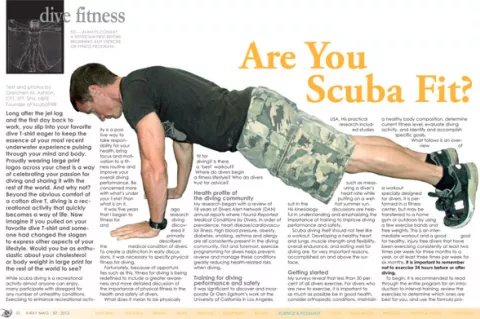Long after the jet lag and the first day back to work, you slip into your favorite dive T-shirt eager to keep the essence of your most recent underwater experience pulsing through your mind and body. Proudly wearing large print logos across your chest is a way of celebrating your passion for diving and sharing it with the rest of the world.
Contributed by
And why not? Beyond the obvious comfort of a cotton dive T, diving is a recreational activity that quickly becomes a way of life. Now imagine if you pulled on your favorite dive T-shirt and someone had changed the slogan to express other aspects of your lifestyle. Would you be as enthusiastic about your cholesterol or body weight in large print for the rest of the world to see?
While scuba diving is a recreational activity almost anyone can enjoy, many participate with disregard for any number of unhealthy conditions. Exercising to enhance recreational activity is a positive way to take responsibility for your health, bring focus and motivation to a fitness routine and improve your overall diving performance. Be concerned more with what’s under your T-shirt than what is on it.
It was five years ago that I began to research fitness for diving and discovered it primarily described the medical condition of divers. To create a distinction in early discussions, it was necessary to specify physical fitness for diving.
Fortunately, because of opportunities such as this, fitness for diving is being redefined to include a greater awareness and more detailed discussion of the importance of physical fitness in the health and safety of divers.
What does it mean to be physically fit for diving? Is there a ‘best’ workout? Where do divers begin a fitness lifestyle? Who do divers trust for advice?
Health profile of the diving community
My research began with a review of 18 years of Divers Alert Network (DAN) annual reports where I found Reported Medical Conditions by Divers. In order of prevalence, heart disease/cardiovascular illness, high blood pressure, obesity, diabetes, smoking, asthma and allergy are all consistently present in the diving community. First and foremost, exercise programming for divers helps prevent, reverse and manage these conditions greatly reducing health-related risks when diving.
Training for diving performance and safety
It was significant to discover and incorporate Dr Glen Egstrom’s work at the University of California in Los Angeles, USA. His practical research included studies such as measuring a diver’s heart rate while putting on a wetsuit in the hot summer sun. His kinesiology discussions are helpful in understanding and emphasizing the importance of training to improve diving performance and safety.
Scuba diving itself should not feel like a workout. Developing a healthy heart and lungs, muscle strength and flexibility, overall endurance, and eating well for diving are, for very important reasons, accomplished on and above the surface.
Getting started
My surveys reveal that less than 30 percent of all divers exercise. For divers who are new to exercise, it is important to as much as possible be in good health, consider orthopedic conditions, maintain a healthy body composition, determine current fitness level, evaluate diving activity, and identify and accomplish specific goals.
What follows is an overview of a workout specially designed for divers. It is performed in a fitness center, but may be transferred to a home gym or outdoors by using a few exercise bands and free weights. This is an intermediate workout and a good goal for healthy, injury free divers that have been exercising consistently at least two times per week for three months to a year, or at least three times per week for six months. It is important to remember not to exercise 24 hours before or after diving.
To begin, it is recommended to read through the entire program for an introduction to interval training, review the exercises to determine which ones are best for you, and use the formula provided to determine your training heart rate or aerobic training zones.
The custom program simulates the physiology and biomechanics of diving in an exercise program. This synergistic workout stimulates your mind and body with timed intervals of functional body weight and resistance exercises alternated with timed intervals of aerobic heart rate training. Therapeutic considerations for the knee, shoulder and low back are built into the program.
Consistent participation in exercise promotes weight loss, supplements lean muscle mass, helps prevent osteoporosis, may reverse clinical conditions such as hypertension and high cholesterol and can be an excellent pain management tool for all forms of arthritis. As a diver, you may directly benefit with improved endurance on land and in the water, more stability on the boat and for shore entry, reduced risk of injury and illness, more efficient use of air, and ease of handling gear and tanks.
Aerobic training zones
To maximize the benefits of training, it is necessary to establish your heart rate training zones. These training zones are based on your maximum heart rate, which is the highest number of times your heart can contract in one minute. Working within 60-80 percent of your maximum heart rate is most beneficial for overall health. The 70-80 percent heart rate training zones improve the ability of the body to take in and distribute adequate amounts of oxygen to working muscles during physical activity.
If you have heart conditions, it is recommended that you measure your maximum heart rate by taking a max stress test administered by a physician. Otherwise, the most respected fitness standard for calculating your training heart rate zones is the Karvonen Formula developed by internationally renowned physician and exercise physiologist, Martti Karvonen.
As soon as you wake up in the morning, before you get out of bed, take your resting pulse by placing two fingers under the back corner of your jaw or on your wrist and count your heart beat for one minute. This number is your Resting Heart Rate.
Use this number to perform the following Karvonen calculation. Subtract your age from 220. From this result subtract your Resting Heart Rate (RHR). Then multiply this number by your training intensity of 70 percent (repeat the formula for 80 percent).
Lastly, add your Resting Heart Rate back in to get your Training Heart Rate (THR). An example looks like this: 220 – (AGE) 45 = 175; 175 – (RHR) 68 = 107; 107 x 70% = 75; 75 + (RHR) 68 = 143 (THR).
Using this example, while training in your 70 percent heart rate training zone, you will attempt to maintain a minimum pulse of 143 beats per minute. Your 80 percent heart rate training zone provides a maximum pulse of 154 beats per minute. However, if you are a beginner, work at 60 percent intensity until these higher percentages can be performed while still able to carry on a conversation.
The custom program I describe here applies the 70 percent heart rate training zone primarily to improve the muscle cells ability to utilize oxygen. This zone trains the heart to pump more blood, metabolizes stored body fat as the primary source of energy, is preferred for weight management, and is a healthful intensity in preparation for moderate scuba diving conditions.
Training in the 80 percent zone is most effective for overall cardiovascular fitness. The following custom program uses this heart rate training zone to improve the body’s ability to transport oxygenated blood to the muscle cells and carbon dioxide away from the cells. This zone is also effective for increasing overall muscle strength. A training zone of 80 percent of your maximum heart rate is similar to the work of swimming against a moderate current.
Notably, the 90 percent zone, while sometimes used for short periods to train for high levels of athletic performance, is not considered a healthful zone for recreational activity. However, of considerable importance is that exercising with consistency in the heart rate training zones of 70-80 percent may prepare you for a time when you may need to exert beyond usual conditions.
Training with a heart rate monitor is a great way to easily know if you are working in your training zone and is recommended for individuals with heart disease or pulmonary conditions. It is recommended to rely on heart rate monitors primarily during aerobic intervals. During resistance training intervals your heart rate will naturally fall slightly below your target training zones. ...
( ...)





























